ASUS ML248H: Thin for the Win?
by Chris Heinonen on October 27, 2011 12:00 AM ESTColor Uniformity
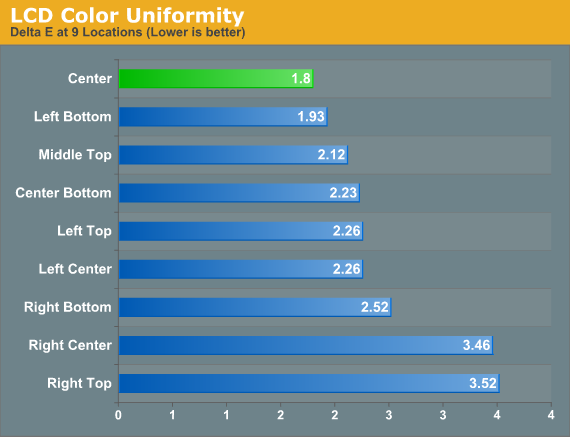
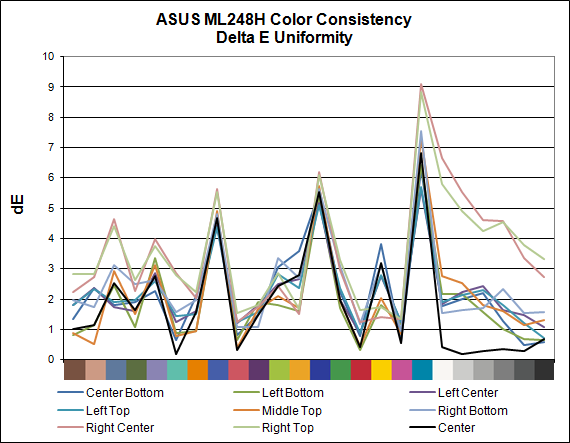
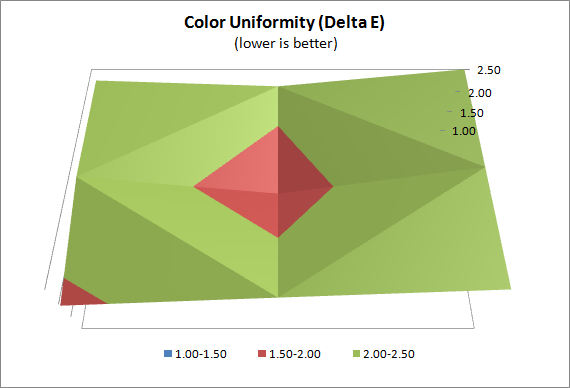
While the center of the ASUS ML248H screen has a decent dE when we analyze it more carefully, the rest of the screen does not fare as well. Only one other location on the screen manages a dE below 2.0, and two measurements are right around 3.5 dE. If you look at the graph you can see that most of the errors are occurring in the same colors, but when you move away from the center of the display, the quality of the grayscale really goes downhill.
I’m not sure why the grayscale is so close to perfect at the center and then far worse on the rest of the display, but I’d rather see the issues be in colors than in grayscale. If you are a photographer or artist, you likely aren’t considering a TN display anyway, but even for day-to-day office use the color shift in what should be neutral colors can be very annoying. If you don’t care about calibrating your monitor, then you really aren’t going to be too concerned with this, but for everyone else, the fact that only the dead center of the screen can be close to accurate is going to be an issue I would think.
Color Gamut
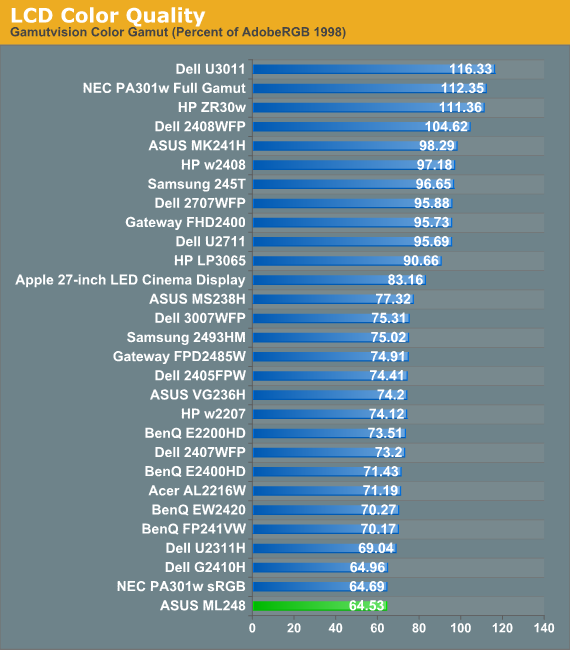
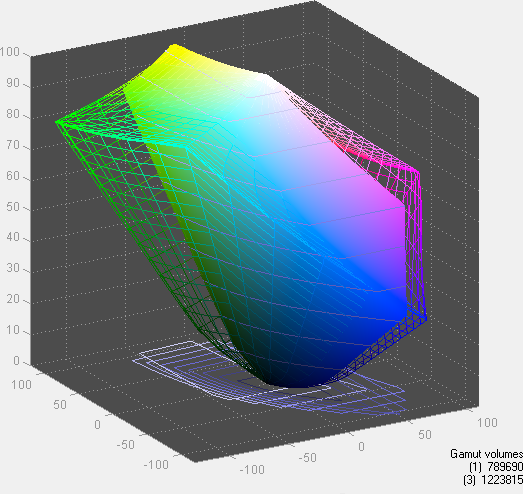
The color gamut on the ASUS comes in on the low side for an sRGB display, with under 65% of the Adobe RGB colorspace represented. This likely contributes to the dE numbers we are seeing, as many of those values are at the edge of the sRGB colorspace, and the ASUS ML248H might simply not be able to produce them.










57 Comments
View All Comments
Arbie - Friday, October 28, 2011 - link
How can a major company produce any monitor today without a height adjustment? And especially an ultra-thin product, where the mechanical parts required to do so would be minimal. This immediately rules it out of the workplace (where there are legal ergonomic concerns), and off most other people's desktops. Get a clue, Asus. Garden-variety Samsungs have lift, tilt, and even rotation.
JonnyDough - Friday, October 28, 2011 - link
I won't buy anything under 120Hz these days. I do however like the 2ms response time. That meets my standard. Anything over 5ms is a no go for sure. I aim for 2 usually.marraco - Saturday, October 29, 2011 - link
The first and most important aspect I look for on any monitor review is blurring of moving images.This article is completely worthless to me.
shashank7040 - Tuesday, November 1, 2011 - link
Asus Eee Pad with slide out QWERTY.........http://goo.gl/B4rJUm0nsier - Saturday, November 5, 2011 - link
I bought the 21.5in version of this monitor (ML228H) for a mere $133 AR. It is surprisingly light and thin. I use it as a portable display for my PS3 (HDMI) which is where the headphone jack comes in handy. It also works well as a second monitor for my laptop, which also uses HDMI. A beautiful display for my gaming/office/web browsing needs, and much better quality than another brand 22" I purchased 2yrs ago. Note: I am not a graphic artist so i cannot compare my experience to an IPS.As for the omission of DVI, my ASUS monitor came with a DVI to HDMI cable for connecting to DVI out, as well as a VGA cable. Both cables approximately 6ft in length. Perhaps the AT reviewer also lost this cable when he lost his screw. Even so you can buy DVI to HDMI adaptors for pocket change.
mbryans - Tuesday, November 22, 2011 - link
Bisakah Anandtech making review about Samsung SyncMaster S23A750D? This monitor seems to be reincarnation of the SyncMaster PX2370.TN Panel (probably hybrid), LED backlit, 23-inch, 1920 x 1080, 2 ms, 120 Hz (3D only for AMD 3D HD), 100% sRGB, and DisplayPort 1.2 (probably first DP 1.2 monitor).
I am interested in the color accuracy of this monitor will be displayed at 120 Hz.
mbryans - Tuesday, November 22, 2011 - link
I mean: Can Anandtech review about Samsung SyncMaster making S23A750D? This monitor seems a to be Reincarnation of the SyncMaster PX2370.